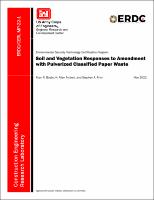Please use this identifier to cite or link to this item:
https://hdl.handle.net/11681/44202Full metadata record
| DC Field | Value | Language |
|---|---|---|
| dc.contributor.author | Busby, Ryan R. | - |
| dc.contributor.author | Torbert, H. Allen | - |
| dc.contributor.author | Prior, Stephen A. | - |
| dc.creator | Construction Engineering Research Laboratory (U.S.) | - |
| dc.date.accessioned | 2022-05-06T17:07:34Z | - |
| dc.date.available | 2022-05-06T17:07:34Z | - |
| dc.date.issued | 2022-05 | - |
| dc.identifier.govdoc | ERDC/CERL MP-22-1 | - |
| dc.identifier.uri | https://hdl.handle.net/11681/44202 | - |
| dc.identifier.uri | http://dx.doi.org/10.21079/11681/44202 | - |
| dc.description | Miscellaneous Paper | en_US |
| dc.description.abstract | The United States Army produces a significant amount of classified paper waste that is pulverized to a fine consistency unsuitable for recycling. However, cheap, high quality organic materials such as classified paper waste are useful as soil amendments. The objective of this research was to evaluate the utilization of pulverized classified paper waste as a soil amendment to improve soil health and increase establishment of desirable native grasses on degraded Army training lands. Paper was applied at rates of 9 to 72 Mg ha⁻¹ to two soil types at Fort Polk, LA: an alfisol (very fine sandy loam - Fine, smectitic, thermic Chromic Vertic Hapludalfs) and an ultisol (loamy fine sandy - Loamy, siliceous, semiactive, thermic Arenic Paleudults). These are common soil orders found on military training lands nationwide and represent fertile (alfisol) and unfertile (ulitsol) soils. Vegetation and soils were monitored over 2 growing seasons. No increase in heavy metals were observed in soils. Extensive analysis showed very low levels of regulated contaminants in the paper, but most were below detection limits. The ultisol site showed improved soil physical and chemical properties, while desirable vegetation benefitted from nutrient immobilization at the alfisol site. Based on the results of this study, applying pulverized paper waste to soil at a rate of 35.9 Mg ha⁻¹ is recommended. Application of paper waste to soils had no adverse environmental effects, improved soil physiochemical properties, and facilitated establishment of desirable native vegetation. | en_US |
| dc.description.sponsorship | Environmental Security Technology Certification Program (U.S.) | en_US |
| dc.format.extent | 30 pages / 676.35 kB | - |
| dc.format.medium | PDF/A | - |
| dc.language.iso | en_US | en_US |
| dc.publisher | Engineer Research and Development Center (U.S.) | en_US |
| dc.relation.ispartofseries | Miscellaneous Paper (Engineer Research and Development Center (U.S.)) ; no. ERDC/CERL MP-22-1 | - |
| dc.relation.isversionof | Busby, Ryan R., H. Allen Torbert, and Stephen A. Prior. "Soil and vegetation responses to amendment with pulverized classified paper waste." Soil and Tillage Research 194 (2019): 104328. https://doi.org/10.1016/j.still.2019.104328 | - |
| dc.rights | Approved for Public Release; Distribution is Unlimited | - |
| dc.source | This Digital Resource was created in Microsoft Word and Adobe Acrobat | - |
| dc.subject | Land rehabilitation | en_US |
| dc.subject | Native grasses | en_US |
| dc.subject | Pulverized paper | en_US |
| dc.subject | Low soil fertility | en_US |
| dc.title | Soil and vegetation responses to amendment with pulverized classified paper waste | en_US |
| dc.type | Report | en_US |
| Appears in Collections: | Miscellaneous Paper | |
Files in This Item:
| File | Description | Size | Format | |
|---|---|---|---|---|
| ERDC-CERL MP-22-1.pdf | 676.35 kB | Adobe PDF |  View/Open |